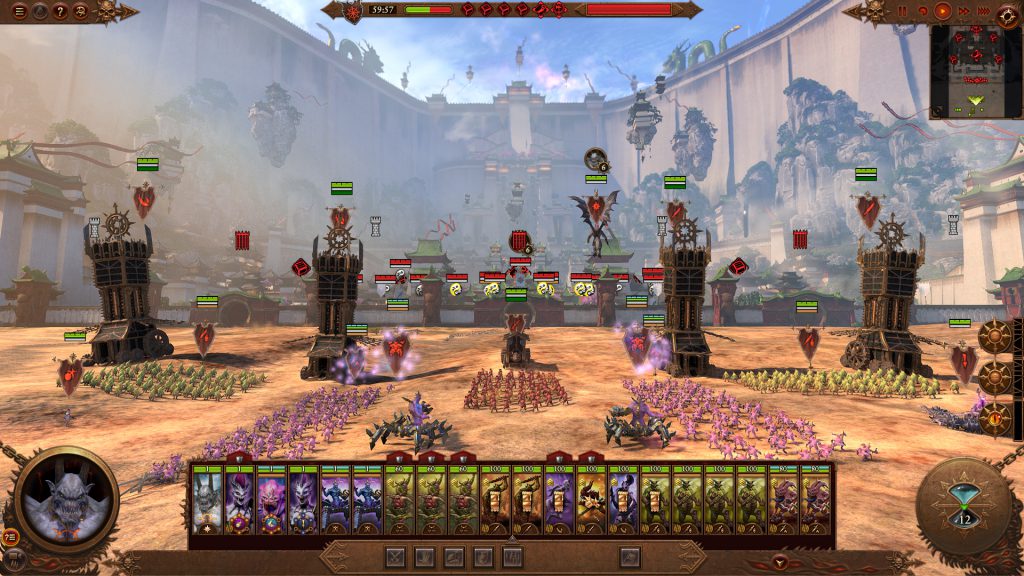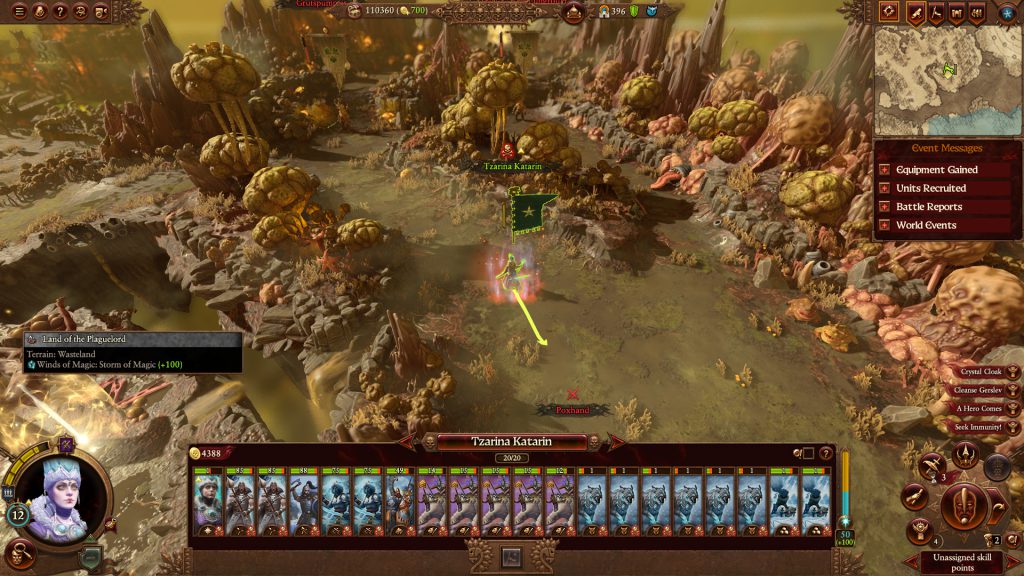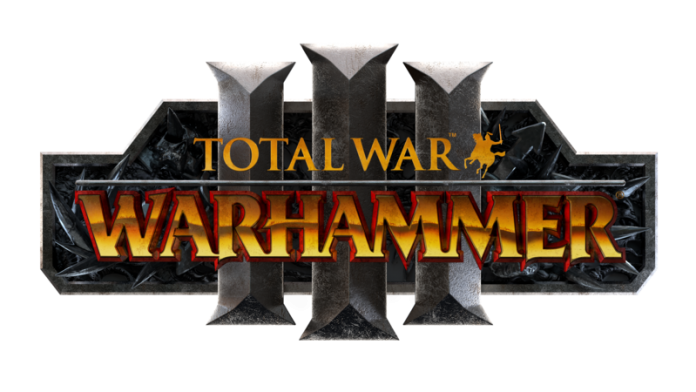For those of you who have been following my articles on this game series – in particular my first impressions article – you know that I’m very excited about this release. Creative Assembly bringing the Warhammer universe to life has been one of the most exciting things for me as a Warhammer fan, as well as a lot of us here in the Goonhammer offices. Everyone’s been talking about starting our first eight-player campaigns and truly exploring what this game has to offer. The first game from the Total War Warhammer series was amazing, the second game brought us into a giant world of what could be with their Mortal Empires DLC, and now this third game is bringing us into a full circle that I am deeply appreciative of.
Before we dive into this review, we’d like to thank Creative Assembly for sending us a review copy of the game.
Spoiler Warning: This article contains mild plot details and discusses the endgame mechanics
Welcome Back
After spending time in the more familiar parts of the Old World with Total War: Warhammer 1 and 2, this third instalment takes on the massive task of introducing us to the eastern part of the continent and the Realms of Chaos to the north. This is an interesting challenge, as most of these parts of the Old World were hinted at more than visualized, and so will be entirely new for many players. The realms of Chaos Daemons, the Bear God Ursun, and the gluttonous, mercenary race of the Ogres all feel like something pulled from a high fantasy novel we might have read in the early 90s.
The good news is that Creative Assembly presents each of these realms – and the factions that populate them – in an exciting way, with a story that weaves them all together and gives each something to strive for. There are eight distinct factions in this latest outing, and each one feels significantly different in terms of play style:
- Chaos Undivided
- Khorne
- Slaanesh
- Tzeentch
- Nurgle
- Kislve
- Cathay
- Ogre Kingdoms (available as DLC)
For this review I’ve played just over 23 hours across all 8 campaigns, averaging about 4 hours per faction, though I haven’t completed any one of the campaigns yet. I also haven’t yet had a chance to play the game multiplayer.

Even for experienced players, the tutorial/prologue is a required part of the experience, and I’d recommend playing it before you dive into the game proper. The tutorial does a good job setting up the core storyline of the game’s campaigns, telling us how and why the Great Bear Urson is missing and how he ended up in dire straits to begin with. This story of a doomed heroic party traveling north only to find themselves corrupted by the forces they fought against isn’t new, but it’s effectively told and lays the groundwork for the rest of the game.
This is also where the game introduces you to new mechanics, including the Outpost system, which allows you to build units that you normally don’t have access to. When you reach a certain requisition point with your allies, you’re able to build some of those allies’ unique units. For players who want to focus more on battles, Empire Management makes it easy to manage diplomacy, upgrades, and outpost building without having to dig too far into the minutiae.
Picking up the game a second time, cathay became my go-to faction, as i found them to be the most forgiving to play.
In my first play experience with TWW3 – the preview I wrote about for the First Impressions article, I played with both the daemonic legions of Chaos Undivided and the noble defenders of Cathay, and walked away finding the latter to be the less fun of the two. Picking the game up a second time, they became my go-to faction, as I found them to be the most forgiving to play. As I made bad decisions with my army or deployments, I’d find myself overwhelmed by the AI sending attack after attack against my main army. With Cathay, I suddenly started to see the value in keeping my units together and benefitting from the bonuses. These bonuses would in turn end up being overwhelmingly positive in these combats, and I finally started enjoying the way the army was meant to be played – something I’d missed out on the first time playing the army. Eventually I’d end up forming a powerful front line, and then I’d just let waves and waves of daemons crash upon them.
In exploring the game’s other factions, I found a soft(?) spot in my heart for the forces of Slaanesh, who I’ll admit I thought would be terrible to play. I pictured them as a soft force with poor leadership, who’d be quickly defeated in battle. Instead, I was pleasantly surprised to find them a faction that encouraged an active playstyle, always looking for the next flank charge and finding ways to squeeze the most out of your units’ advantages. It ended up being one of the most difficult yet rewarding play experiences I’ve come across in a Total War faction.
If you’re new the game/series, or looking to ease into the difficulty curve, I’d recommend starting with Grand Cathay or the Daemons of Chaos Undivided, who offer a more forgiving experience.

True to the series, the game’s environments are once again gorgeous. From The Great Maw worshipped by the Ogre Kingdoms, visualized here for the first time in Warhammer lore, to the massive gods of Chaos, thundering in the sky as you fight in front of their citadels, the game is filled with environments that are deep, inviting, and rewarding from a lore perspective. Creative Assembly has always been known for putting work into the environments and that effort shows here. When I finally started doing siege battles, the pure scale of the conflicts and cities compared to past games made them feel new and exciting. Gone are the days of just having a single wall for your forces to run into; now there are layered cities, something along the lines of Total War: Attila.
So far, this might seem like an overly positive review. And at the end of the day, all I have are wonderful things to say about the game. I haven’t yet had a chance to dive into the multiplayer or the game’s shared campaign feature, but I cannot wait to start. But there are some negative things to mention, and that brings me to the most difficult part of the game to discuss: The game’s main objective – invading the realms of Chaos.
As much as I have glowing things to say about this game, the endgame was the one thing that I found to be a letdown.
One of the primary objectives of the campaign – if not the core thing – is invade the Realms of Chaos, defeating a major enemy in each of the four realms, in order to unlock the game’s final boss/conflict. As the endgame starts, portals to the realms of Chaos open up across the map and it’s up to you to head through them and fight some battles. But you’re not the only one trying to go in and defeat these champions; everyone’s looking to do the same thing and so you’re competing against the game’s other factions and the clock, which lends the situation a feeling of haste and necessity.
When the portals open, dozens and dozens of them show up across the map, making it possible to jump in one with your primary Legendary Lord and go after one of these major enemies with all your power. This means that much of the game’s focus is on building the most powerful primary army you can and waiting for a portal to open, so you can send them through to conquer the realm. In that sense you can’t afford to invest your big army in fighting some random cities only to have them lose the race to get to the Khorne champion; if an enemy faction beats you in the race or you lose a battle in that realm of Chaos you’ll have to try again and you may have to wait dozens of turns before gates open up again and you get another chance to return. Conquering a realm on your first attempt is far from guaranteed.
All of this contributed to a feeling of being pushed that was difficult to get over – I felt compelled to constantly expand my armies outside of city defense. I didn’t see a reason to ally with other factions. All I had to do was consolidate my empire, build a single powerful force, and then send them through the portals. Compared to the endgame from Mortal Empires, or even the original Total War: Warhammer’s build toward a final showdown with Chaos, the endgame here didn’t stick the landing. Here it didn’t feel like a conflict of the Old World vs. Chaos, but rather as though we were in a rally race. As much as I have glowing things to say about this game, the endgame was the one thing that I found to be a letdown. The net result was that it was hard to stay invested in the storyline, and I became more enthralled by the notion of creating fun one-on-one battles.

On a positive note with the storyline, there are some great cinematic sequences to watch. Cinematics were used rarely for storytelling purposes in the Total War Warhammer universe in prior games, only used for major plot points. On the other hand they’re used much more liberally here; TWW3 has a large number of storyboard-like animatics with some great voiceover work. From the voices of the guttural Daemons of Nurgle, to the pleading voice of the Narrator. We are introduced to a fantastic level of immersion that was not as present in the prior instalments.
Ultimately this is, without a doubt, the best Total War game in terms of environment and gameplay and rounds out a truly stellar trio of games. There was a time when I thought Total War: Three Kingdoms would be the most fun I’d ever have in Total War battles. Then I sent hordes of Seekers of Slaanesh crashing into Hordes of Juggernauts of Khorne, while my allies from random Chaos tribes crashed into their flanks. And that wonderful fanboy moment reminded me why I was playing these games to start with.
The Final Verdict:
Overall, Total War: Warhammer 3 is a gift from Creative Assembly to all us Warhammer fans. It offers the best gameplay and environments of the series and I can’t wait to see how they decide to bring all the games together. This is also going to be a game that you’ll enjoy playing with friends, as I think the eight-player co-op should help cover some of the campaign’s shortcomings – when you see your friends’ armies attempting to take down a certain champion, you can send your army in to stop them. This can create new tensions as everyone attempts to gang up on the player attempting to claim a victory.
I want to thank Creative Assembly one more time for providing me with the game a little ahead of time so I can flush out a deeper review for you guys, and I also want to let you know that Total War: Warhammer 3 will be on PC Game Pass on day one in case you wanted to give it a shot!
Have any questions or feedback? Drop us a note in the comments below or email us at contact@goonhammer.com.


